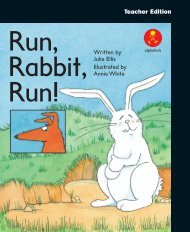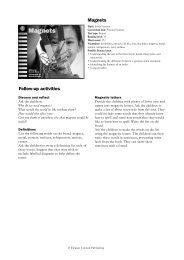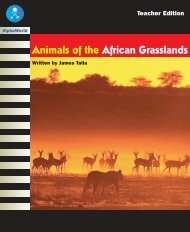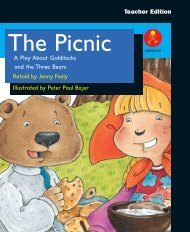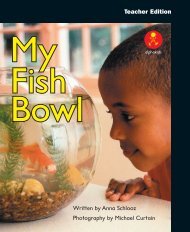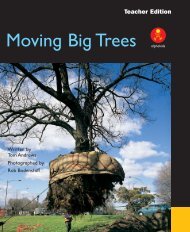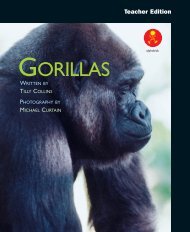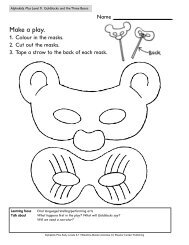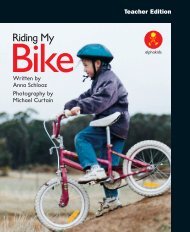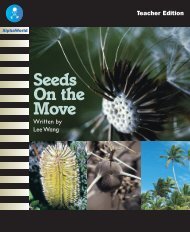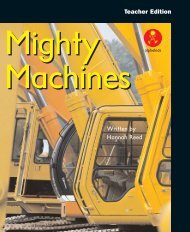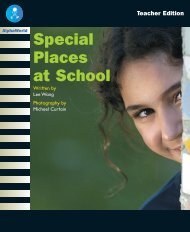L14 TEpp Seahorses - Alpha Literacy
L14 TEpp Seahorses - Alpha Literacy
L14 TEpp Seahorses - Alpha Literacy
Create successful ePaper yourself
Turn your PDF publications into a flip-book with our unique Google optimized e-Paper software.
<strong>Seahorses</strong><br />
Written by Hannah Reed<br />
Teacher Edition<br />
alphakids
Horwitz Education<br />
A Division of Horwitz<br />
Publications Pty Ltd<br />
55 Chandos Street<br />
St Leonards NSW 2065<br />
Australia<br />
Horwitz Gardner<br />
Education<br />
Unit 53, Cressex<br />
Enterprise Park<br />
Lincoln Road<br />
High Wycombe,<br />
Bucks, HP12 3RL,<br />
United Kingdom<br />
Published edition<br />
© Eleanor Curtain<br />
Publishing 2003<br />
First published 2003<br />
Apart from any fair dealing for<br />
the purposes of study, research,<br />
criticism or review, as<br />
permitted under the Copyright<br />
Act of Australia, no part of this<br />
book may be reproduced by<br />
any process, or transmitted in<br />
any form, without permission<br />
of the copyright owner. Where<br />
copies of part or the whole of<br />
this book are made under Part<br />
VB of the Copyright Act, the<br />
law requires that records of<br />
such copying be kept and the<br />
copyright owner is entitled to<br />
claim payment.<br />
Developed by<br />
Eleanor Curtain Publishing<br />
Text: Jenny Feely<br />
Consultant: Susan Hill<br />
Designed by<br />
Alexander Stitt<br />
Production by<br />
Publishing Solutions<br />
Printed in Hong Kong<br />
ISBN 0 7253 2829 0<br />
Pack ISBN 0 7253 2771 5<br />
(6 Student Books + 1 Teacher<br />
Edition)<br />
1 2 3 4 5 6 7 8 9<br />
03 04 05<br />
Text highlights<br />
?<br />
• Question and answer book about seahorses<br />
• Labelled diagrams supply information about<br />
the seahorse’s anatomy<br />
How to use this book<br />
Before reading: Talkthrough<br />
Talk through the book with the children. Encourage<br />
them to predict the text from the cover and the<br />
pictures, and to think about the information they<br />
provide. Direct the children’s attention to aspects of<br />
the text that may challenge them. Support the children<br />
to deal with these challenges by asking the<br />
Talkthrough questions on each page.<br />
During reading: Observe and support<br />
Observe the children as they read. Encourage them to<br />
monitor their own reading as they comprehend the<br />
text. As needed, support children by assisting them to<br />
discover and use reading strategies and cues to solve<br />
problems and respond to reading challenges that arise<br />
in the text. Interruptions to the child’s reading should<br />
be minimal and focused on a specified learning need.<br />
After reading: Comprehension, returning to<br />
the text, responding and writing links<br />
To further develop children’s understanding of the<br />
text, select from activities found on page 12 and the<br />
inside back cover. These whole text, sentence and word<br />
level activities reinforce the teaching focus of this<br />
book. Assessment ideas are provided to assist with<br />
planning for further teaching.<br />
Vocabulary<br />
shallow, seagrass, coral, mangroves, brine<br />
shrimp, pouch, endangered
Setting the context<br />
Ask: What do you know about<br />
seahorses?<br />
Write the children’s ideas on<br />
a chart. If children disagree<br />
about the information<br />
record it anyway and mark<br />
it with an asterisk.<br />
What do you want to know<br />
about seahorses?<br />
List these questions on the<br />
chart also.<br />
<strong>Seahorses</strong><br />
Written by Hannah Reed<br />
alphakids<br />
Front cover<br />
What do you notice about this seahorse?<br />
What colour is it? Where is it swimming?<br />
What kind of animal do you think it is?<br />
Background information<br />
<strong>Seahorses</strong> are fish that live<br />
in seaweed patches close to<br />
the coast. They are<br />
remarkable because the<br />
female seahorse deposits<br />
eggs into the male seahorse’s<br />
pouch. He carries the eggs<br />
until they hatch.<br />
Introducing the book<br />
This book is called<br />
‘<strong>Seahorses</strong>’. It is a question<br />
and answer book that tells<br />
us where seahorses live,<br />
what they eat, how they are<br />
born, how they stay safe<br />
and how they move. It also<br />
tells us why seahorses are<br />
endangered.<br />
<strong>Seahorses</strong><br />
Written by Hannah Reed<br />
alphakids<br />
Title page<br />
What kind of picture is this? What does it tell<br />
us about seahorses?<br />
Point out the tail holding onto the seaweed.<br />
Why might a seahorse hold onto the<br />
seaweed?
<strong>Seahorses</strong> Pages 2–3<br />
2<br />
?<br />
Talkthrough<br />
Discuss the contents page.<br />
How is a contents page organised? What is it for? What will<br />
we find on page 10?<br />
Read through the headings. Point out that each heading is<br />
a question.<br />
What does this tell us about how the book will be written?<br />
Point out that a contents page helps you to choose where<br />
to start reading a book, and that you don’t have to read<br />
from the front to the back.<br />
Observe and support<br />
Can the child explain the purpose of a table of contents?<br />
What is this page called? What is it for? Can you tell me<br />
where I would find out about how a seahorse is born?
Contents<br />
What are seahorses? 4<br />
Where do seahorses live? 6<br />
What do seahorses eat? 9<br />
How are seahorses born? 10<br />
How do seahorses move? 12<br />
How do seahorses stay safe? 14<br />
Are seahorses endangered? 16<br />
3
<strong>Seahorses</strong> Pages 4–7<br />
4<br />
?<br />
Talkthrough<br />
Point out the heading on page 4.<br />
This page tells us that seahorses are not horses at all. What<br />
do you think they are?<br />
Turn to pages 6–7.<br />
Where do seahorses live?<br />
Point out the words that may be unfamiliar to the<br />
children: seagrass, coral reefs, mangroves. Discuss the<br />
meaning of each as needed.<br />
Observe and support<br />
Can the child understand the literal meaning of the text?<br />
How big can a seahorse grow?<br />
Where do seahorses live?
4<br />
6<br />
What are seahorses?<br />
<strong>Seahorses</strong> are not horses at all.<br />
They are fish.<br />
<strong>Seahorses</strong> can be as small<br />
as a little finger nail<br />
or they can grow as long as a hand.<br />
Where do seahorses live?<br />
<strong>Seahorses</strong> live in shallow water<br />
in the sea.<br />
Some seahorses live in seagrass.<br />
Other seahorses live near coral reefs<br />
or in mangroves.<br />
<strong>Seahorses</strong> live in the same place all<br />
of their lives.<br />
5<br />
7<br />
5
<strong>Seahorses</strong> Pages 8–9<br />
6<br />
?<br />
Talkthrough<br />
What is this page about?<br />
The book tells us that seahorses have no teeth. What do you<br />
think they have to do when they are eating small sea<br />
animals?<br />
Point out the diagram and caption.<br />
Observe and support<br />
Does the child use a range of strategies to work out new<br />
vocabulary?<br />
How did you work out the word ‘swallow’?
8<br />
What do seahorses eat?<br />
<strong>Seahorses</strong> eat small sea animals.<br />
<strong>Seahorses</strong> have no teeth.<br />
They have to swallow their food whole.<br />
Some seahorses can eat more than<br />
three thousand brine shrimp each day.<br />
9<br />
7
<strong>Seahorses</strong> Pages 10–13<br />
8<br />
?<br />
Talkthrough<br />
Ask the children look at the illustration on page 11.<br />
What can you see on the seahorse’s stomach? What is<br />
coming out of this pouch?<br />
The text tells us that seahorses have 1000 babies each year<br />
but only about two will grow up. What do you think happens<br />
to all of the other babies?<br />
Look at the diagram on page 12.<br />
Can you point to the seahorse’s fins? What information did<br />
you use to work that out?<br />
Point out the conventions used in diagrams: pointers,<br />
labels, caption.<br />
Observe and support<br />
Does the child use their knowledge of phonics to support<br />
their reading? Read the word ‘hatch’. Does the child<br />
recognise that /tch/ represents a sound?<br />
Can you show me the part of this word that makes the<br />
sound /ch/?
How are seahorses born?<br />
The female seahorse lays her eggs<br />
into the male’s pouch.<br />
Three weeks later the eggs hatch.<br />
The baby seahorses swim out<br />
of the pouch.<br />
A pair of seahorses has about<br />
1000 babies each year.<br />
Only about two of the baby seahorses<br />
will grow up.<br />
The male seahorse gives birth<br />
to the baby seahorses.<br />
10 11<br />
How do seahorses move?<br />
<strong>Seahorses</strong> move by waving a fin<br />
on the back of their bodies and on<br />
their heads.<br />
fin<br />
tail<br />
fin<br />
eye<br />
pouch<br />
<strong>Seahorses</strong> use their tails to hold on to<br />
seagrass. This stops the waves from<br />
washing the seahorses away.<br />
<strong>Seahorses</strong> can move each of their eyes separately.<br />
12 13<br />
9
<strong>Seahorses</strong> Pages 14–16<br />
10<br />
?<br />
Talkthrough<br />
Can you find the seahorse in this photograph? Why do you<br />
think it is hiding in the coral? The book tells us another way<br />
that seahorses hide. What do they do?<br />
Turn to page 16. Discuss what the word ‘endangered’<br />
means.<br />
Can you name two reasons why seahorses are endangered?<br />
Observe and support<br />
Can the child read the text fluently?<br />
Model reading a passage of the text to the child. Have the<br />
child read it with you.<br />
Can you make it sound like I do?<br />
Have the child read the text by themselves.
14<br />
16<br />
How do seahorses stay safe?<br />
<strong>Seahorses</strong> hide to stay safe.<br />
Are seahorses endangered?<br />
<strong>Seahorses</strong> are endangered.<br />
Some people catch them.<br />
And many of the places they live in<br />
are being polluted.<br />
Some seahorses can change colour<br />
to look like where they live.<br />
Other animals cannot see them.<br />
15<br />
11
<strong>Seahorses</strong><br />
12<br />
Being a meaning maker<br />
Encourage the children to support<br />
their answers with evidence from the<br />
book as they discuss these questions:<br />
What is a seahorse?<br />
What do seahorses eat?<br />
What would you need to provide if you<br />
were going to keep a seahorse in an<br />
aquarium?<br />
Being a code breaker<br />
Children may like to explore the<br />
following language features:<br />
• Use of question marks.<br />
• Words with the phoneme ‘l’: live,<br />
all, small, little, nail, shallow,<br />
animals, whole, lays, female, male’s,<br />
later, only, will, hold, tails, colour,<br />
look, like, people, places, polluted.<br />
These words could be grouped<br />
according to the letters (l, ll, le) used<br />
to represent the sound.<br />
• The rime ‘ail’: tail, nail.<br />
Being a text user<br />
Review the chart that was made prior<br />
to reading the book.<br />
What did we learn by reading the book?<br />
Compare the information in the book<br />
with the information recorded in the<br />
chart. Discuss any discrepancies.<br />
Now look at the questions children<br />
raised prior to reading the book.<br />
Did the book provide answers to all of<br />
these questions?<br />
Which questions do we need to<br />
research further? How can we do this?<br />
Being a text critic<br />
What did the author need to know to<br />
write this book?<br />
Where might the author have found the<br />
information she used?<br />
What information has the author left<br />
out?<br />
How would you write a book about<br />
seahorses?
Responding to text<br />
Children could make a poster<br />
about why seahorses are<br />
endangered and what could be done<br />
to protect them. Children could give<br />
a verbal presentation about their<br />
posters.<br />
Children could work in<br />
cooperative groups to make a<br />
collage of a seahorse’s habitat. Supply<br />
large sheets of paper, coloured paper,<br />
cellophane, sand and glue. Encourage<br />
children to write captions and labels<br />
for their collage.<br />
Children could list a range of<br />
words that describe seahorses.<br />
Assessment<br />
Writing links<br />
Shared writing<br />
Discuss the structure of a question<br />
and answer book.<br />
What does each heading start with?<br />
What comes next?<br />
List a range of questions about<br />
seahorses for which children could<br />
write answers. Point out the use of the<br />
question mark.<br />
Write the answer for one question.<br />
Independent writing<br />
Children could write a question and<br />
answer book about an animal of their<br />
choice.<br />
Can the child:<br />
• Read labelled diagrams?<br />
• Use a range of information on the page to support comprehension?<br />
whole text activity sentence activity word activity
<strong>Seahorses</strong><br />
Written by Hannah Reed<br />
alphakids<br />
Teacher<br />
Edition<br />
Topic: Living things<br />
Curriculum link: Science<br />
Text type: Question and answer<br />
Reading level: 14<br />
Word count: 193<br />
Vocabulary: shallow, seagrass, coral, mangroves,<br />
brine shrimp, pouch, endangered<br />
Possible literacy focus<br />
Reading labelled diagrams.<br />
Using a range of visual information to enhance<br />
understanding.<br />
Summary<br />
This book explores what seahorses are, where they<br />
live, what they eat and how they reproduce.<br />
ISBN 0- 7253- 2829- 0<br />
9 780725 328290<br />
Other books<br />
at this level<br />
Our Classroom<br />
Pet<br />
alphakids<br />
Written by Jack Hastings<br />
Photography by Michael Curtain<br />
Snip! Snap!<br />
Written by Lynette Ind Illustrated by Peter Paul Bajer<br />
alphakids<br />
alphakids<br />
Fantastic<br />
Frog Facts<br />
Written by Sarah O’Neil<br />
Crocodile Watching<br />
Written by Mary-Anne Creasy<br />
Photography by Michael Curtain<br />
The Hungry Baby<br />
Written by<br />
Jenny Feely<br />
Illustrated by<br />
Chantal Stewart<br />
alphakids<br />
alphakids<br />
alphakids



